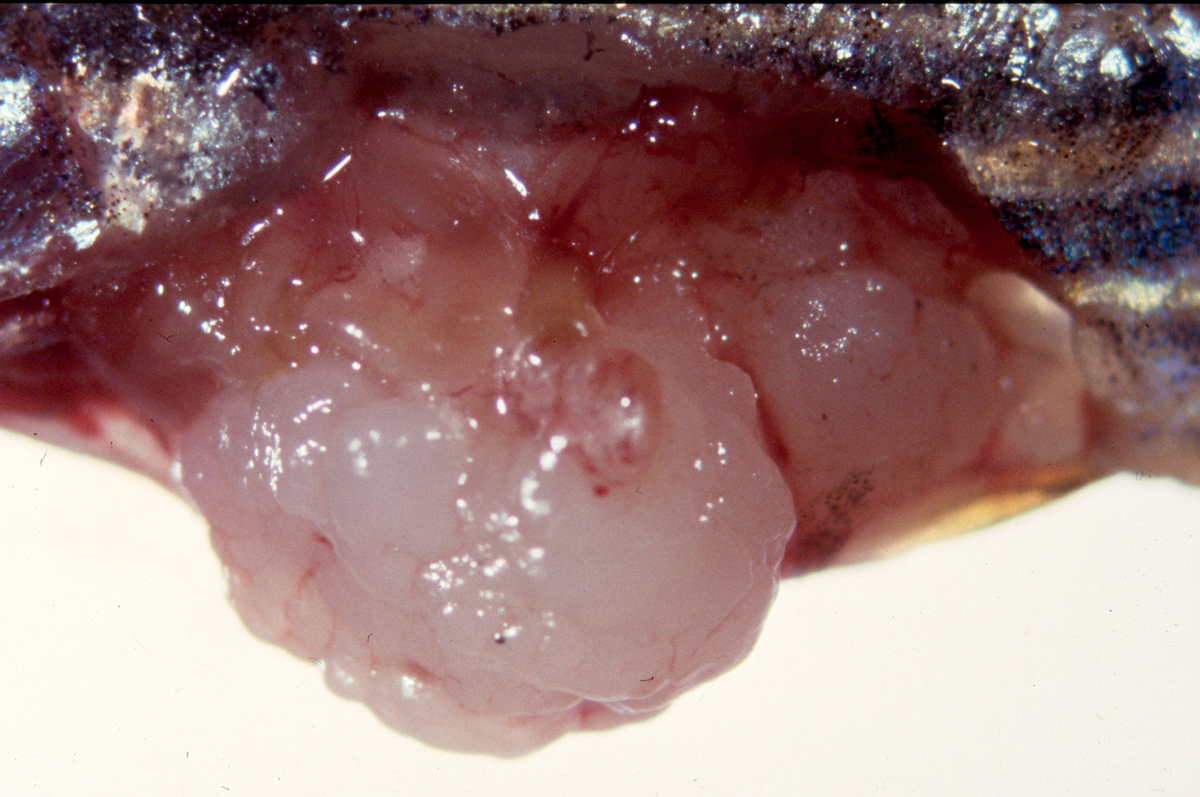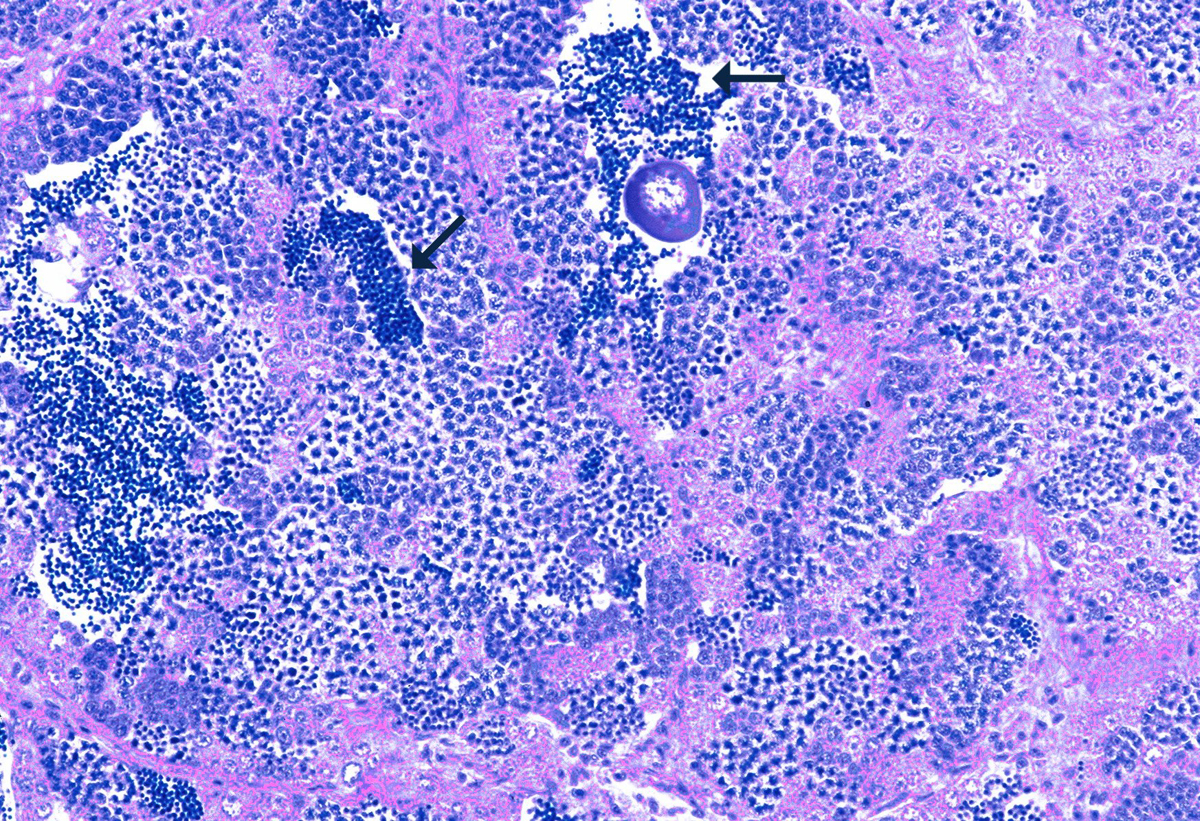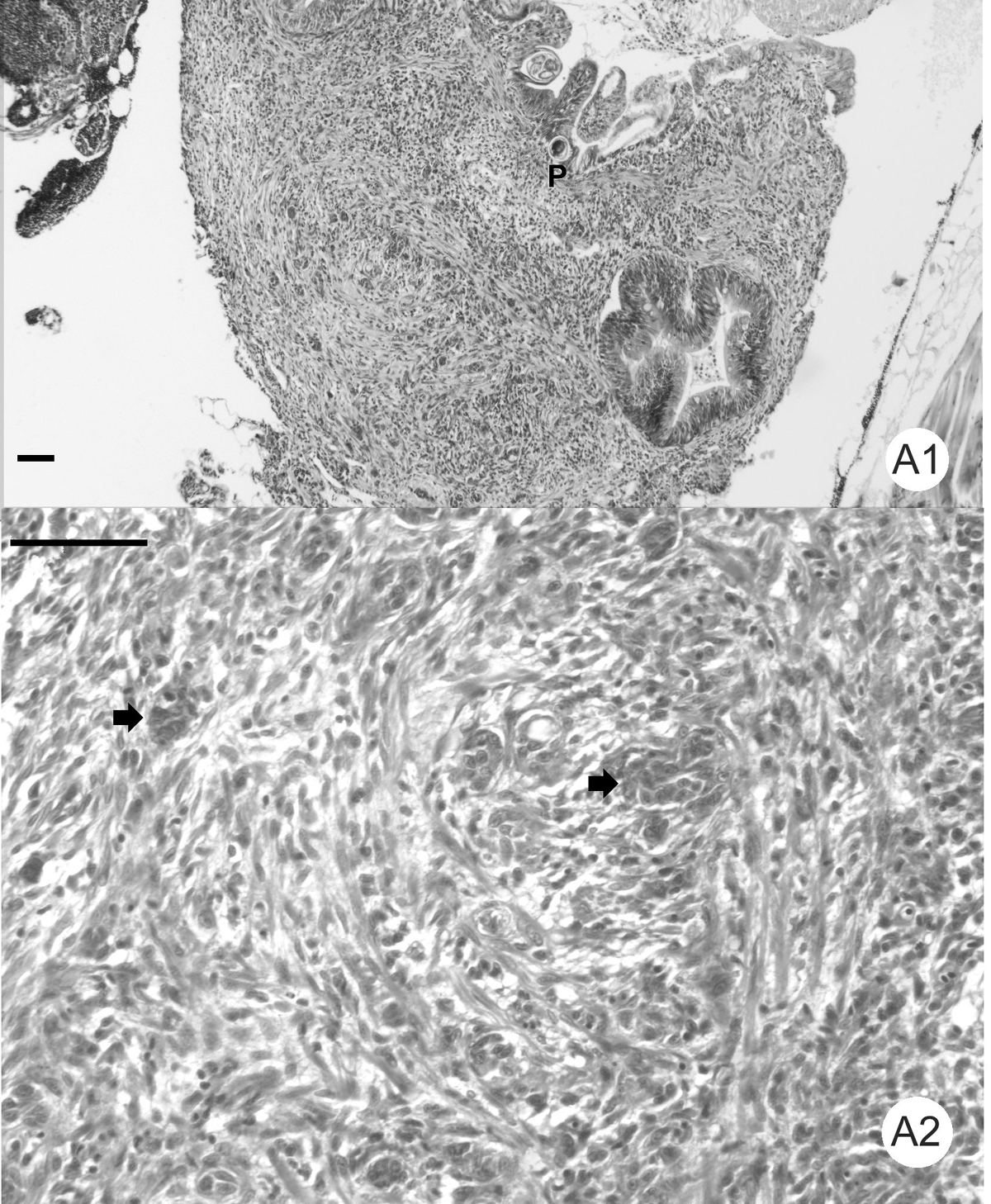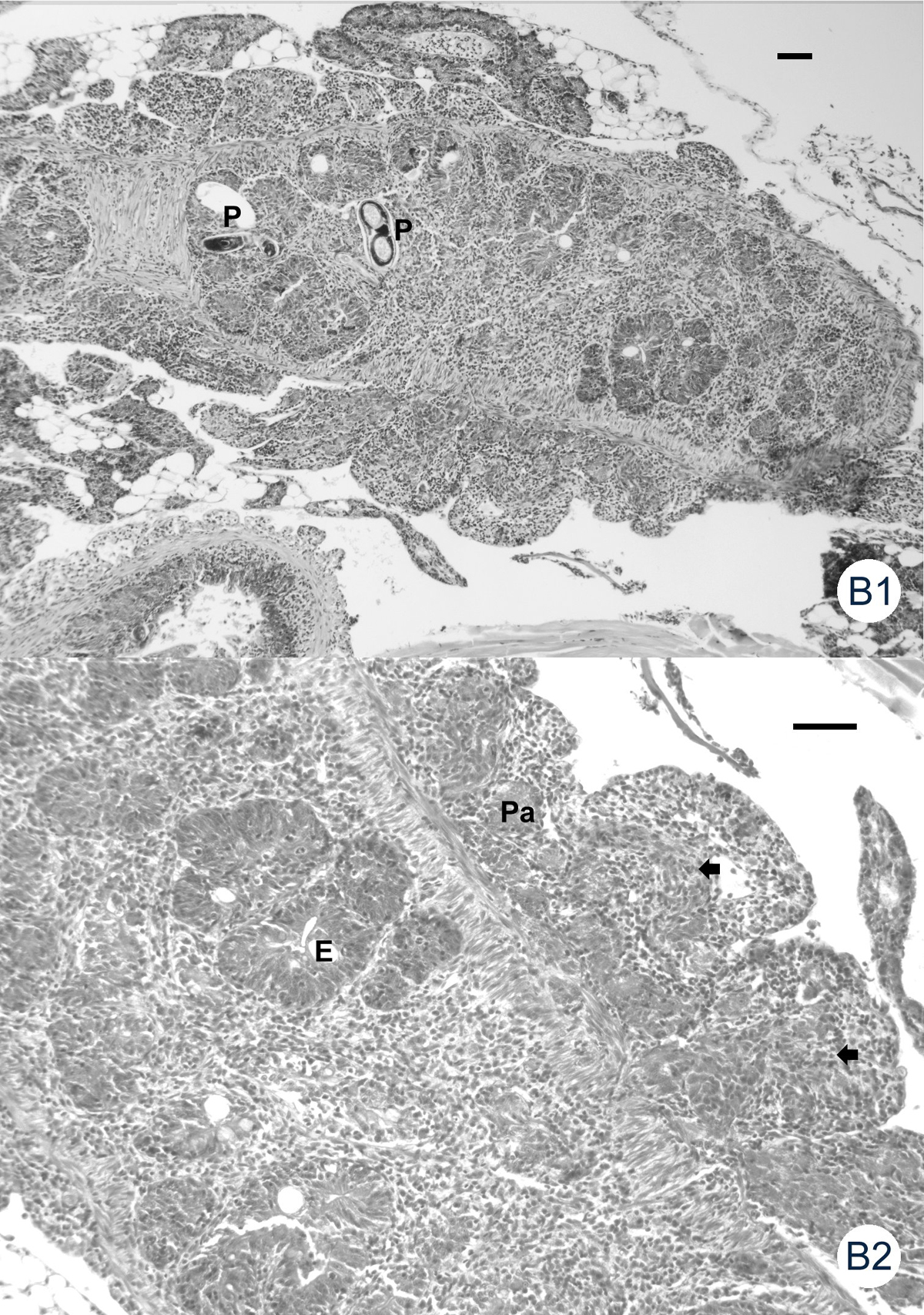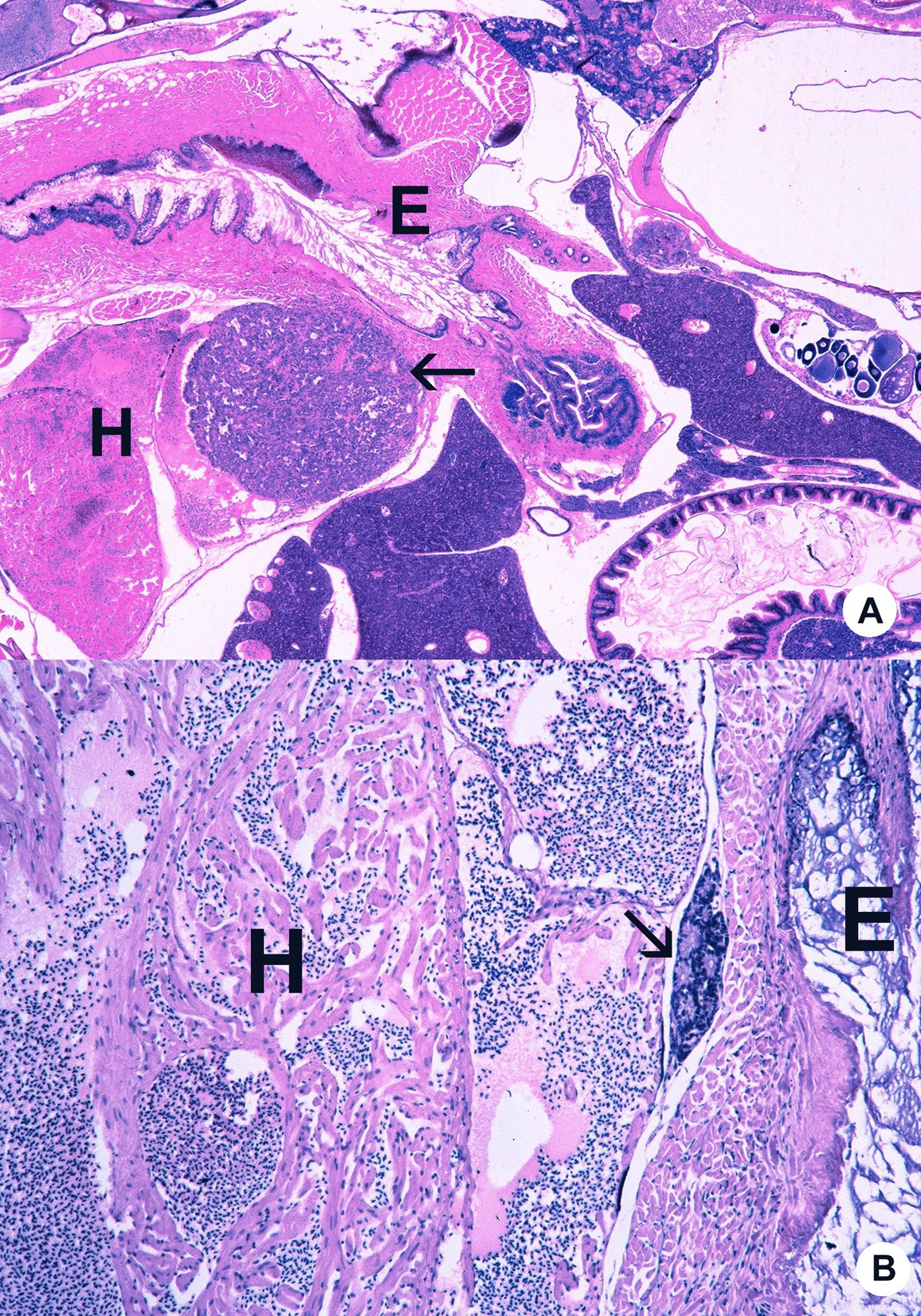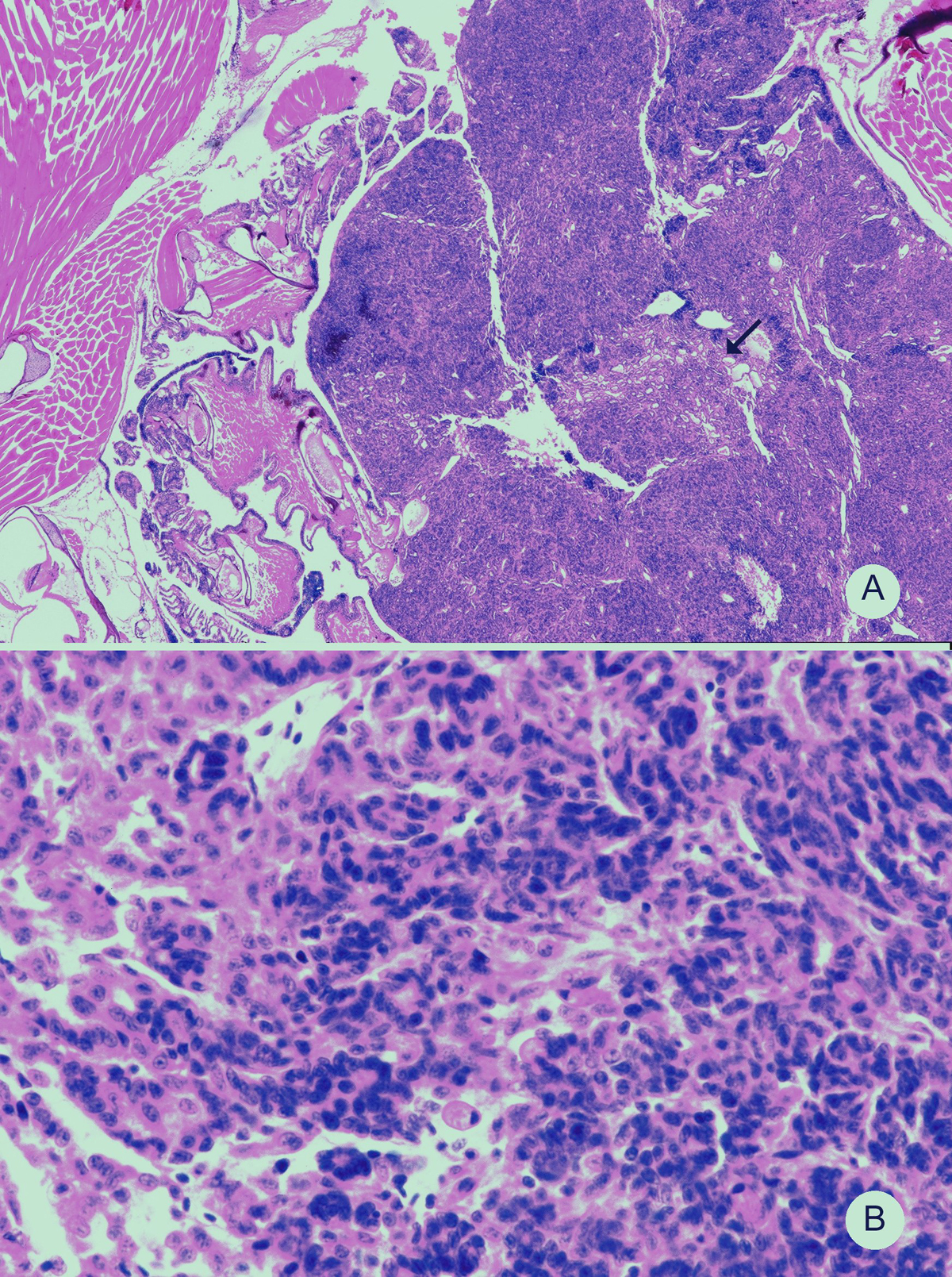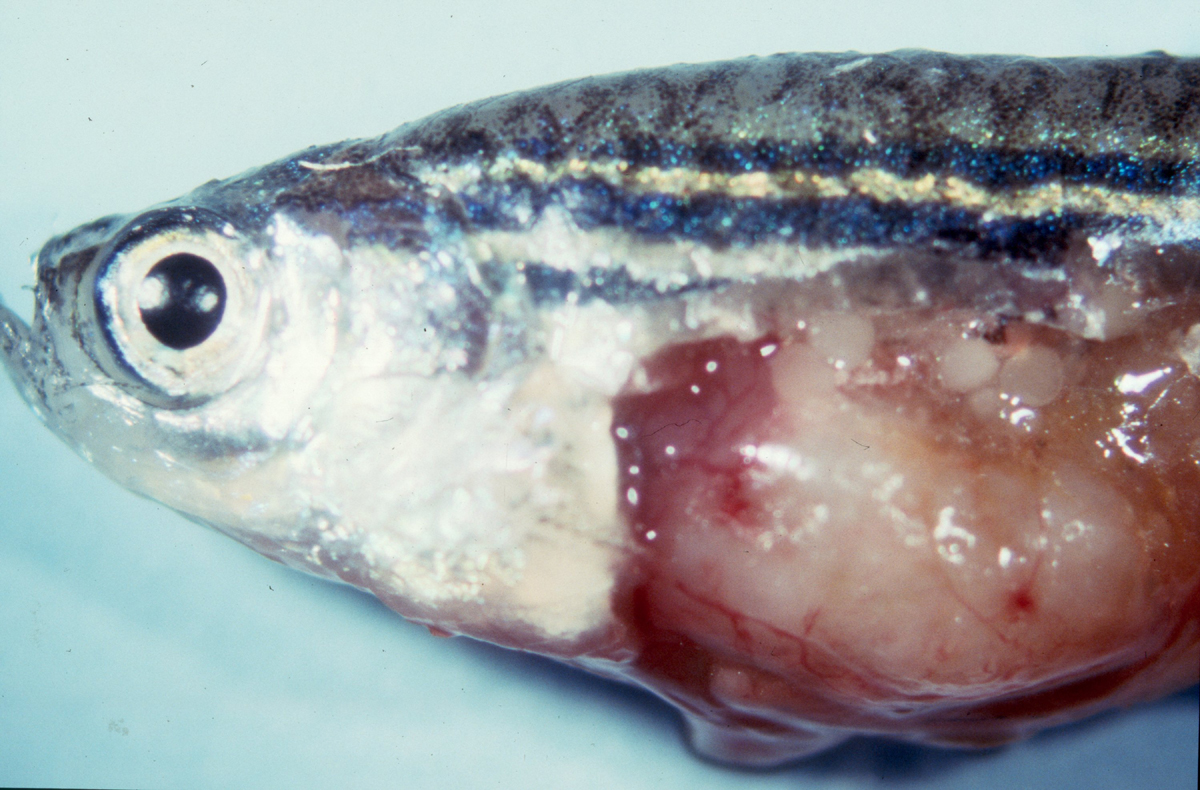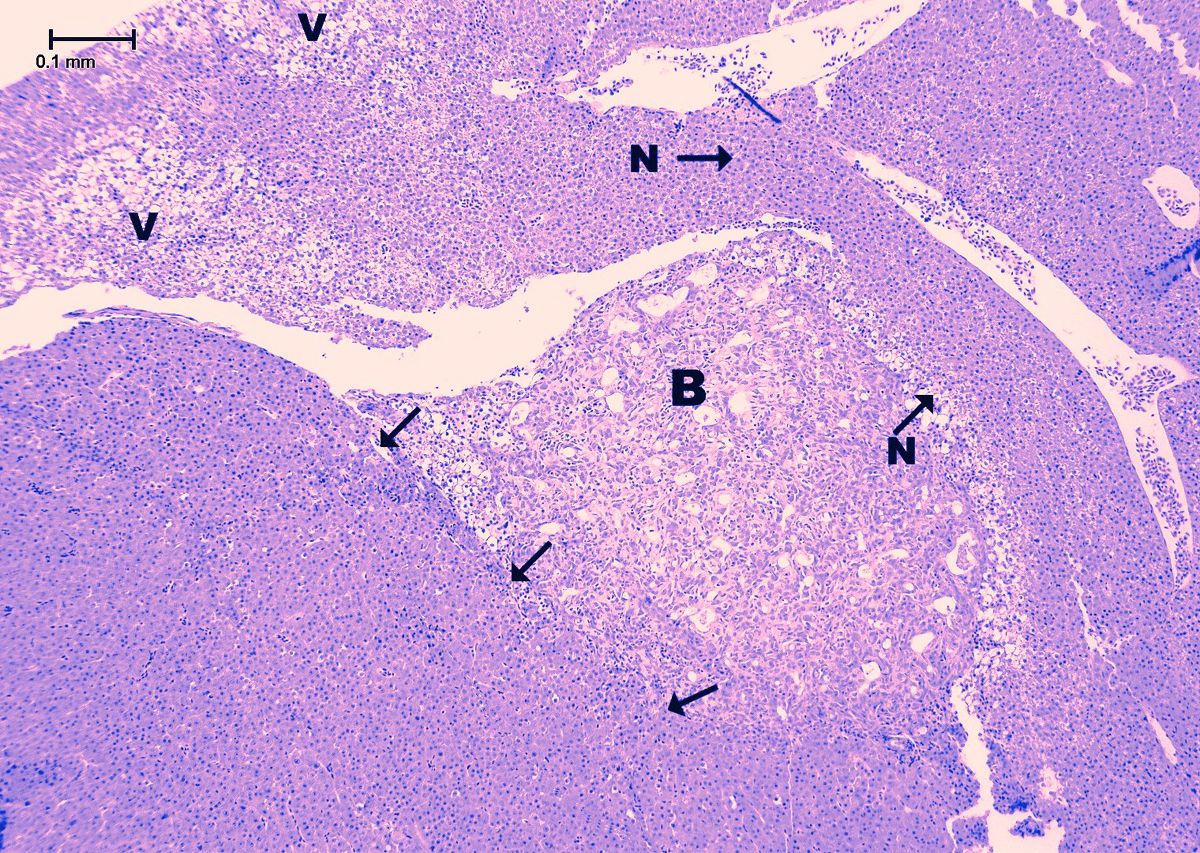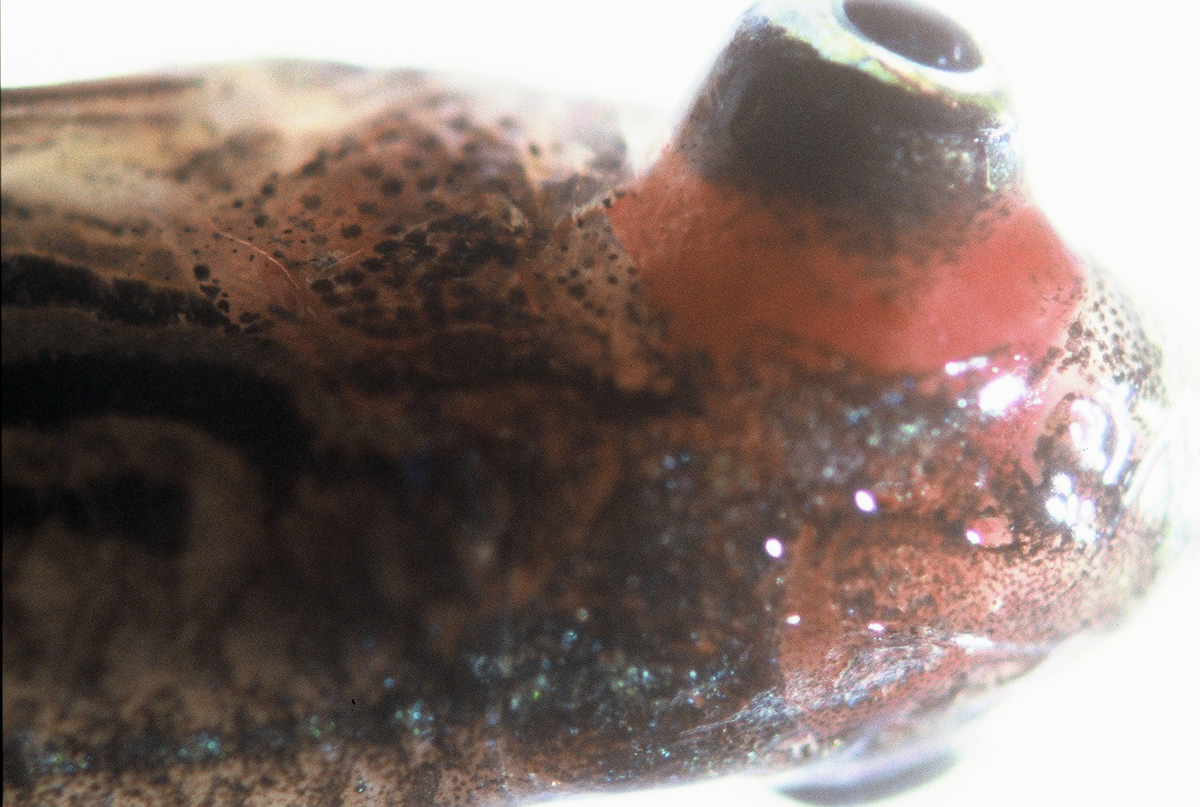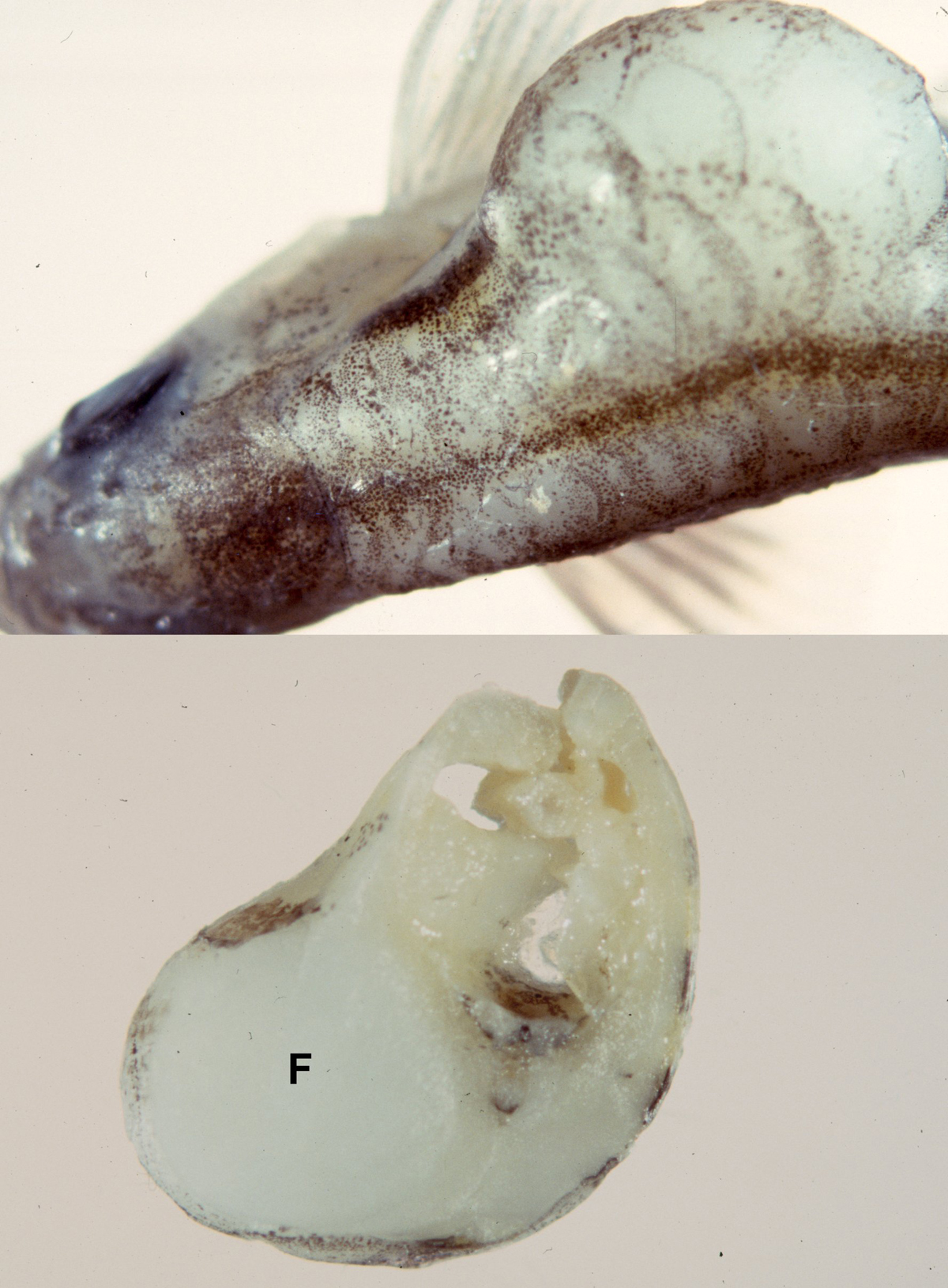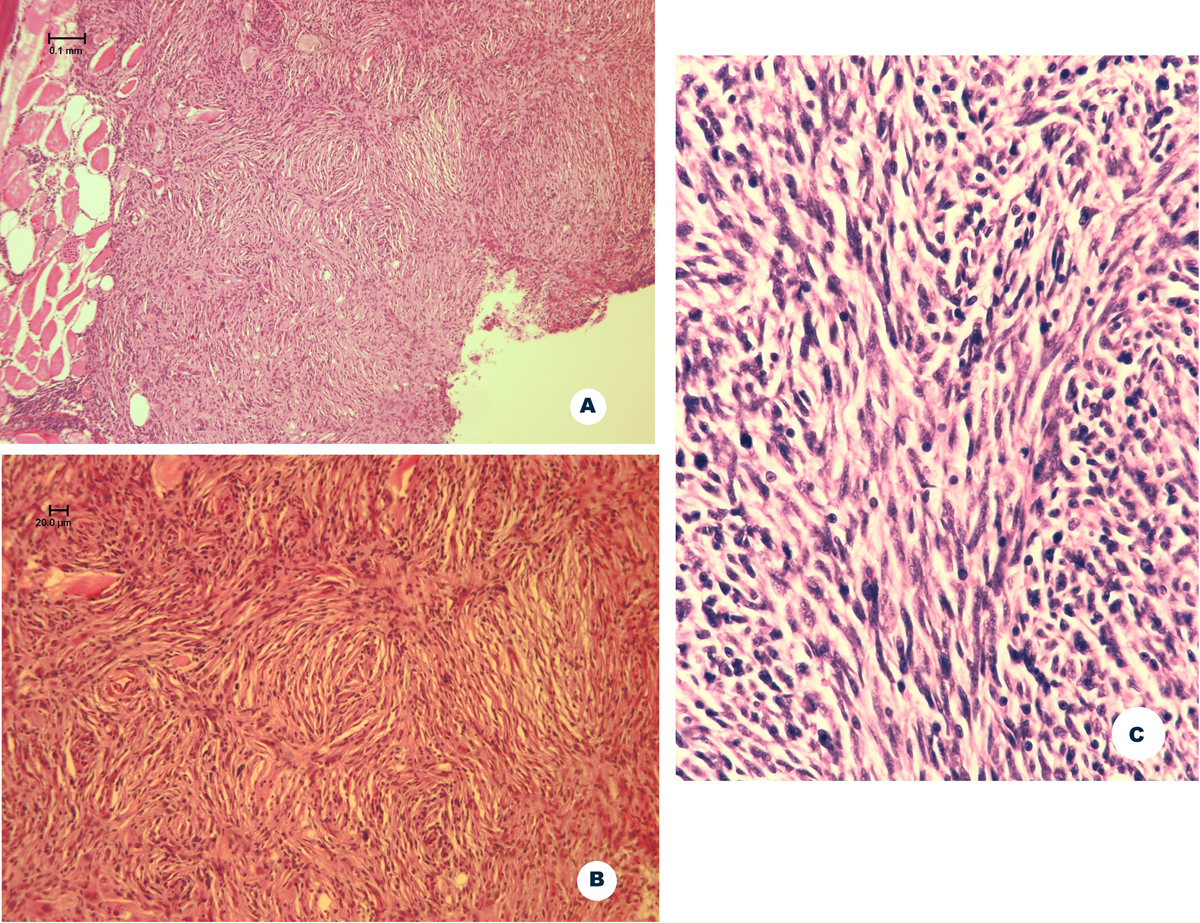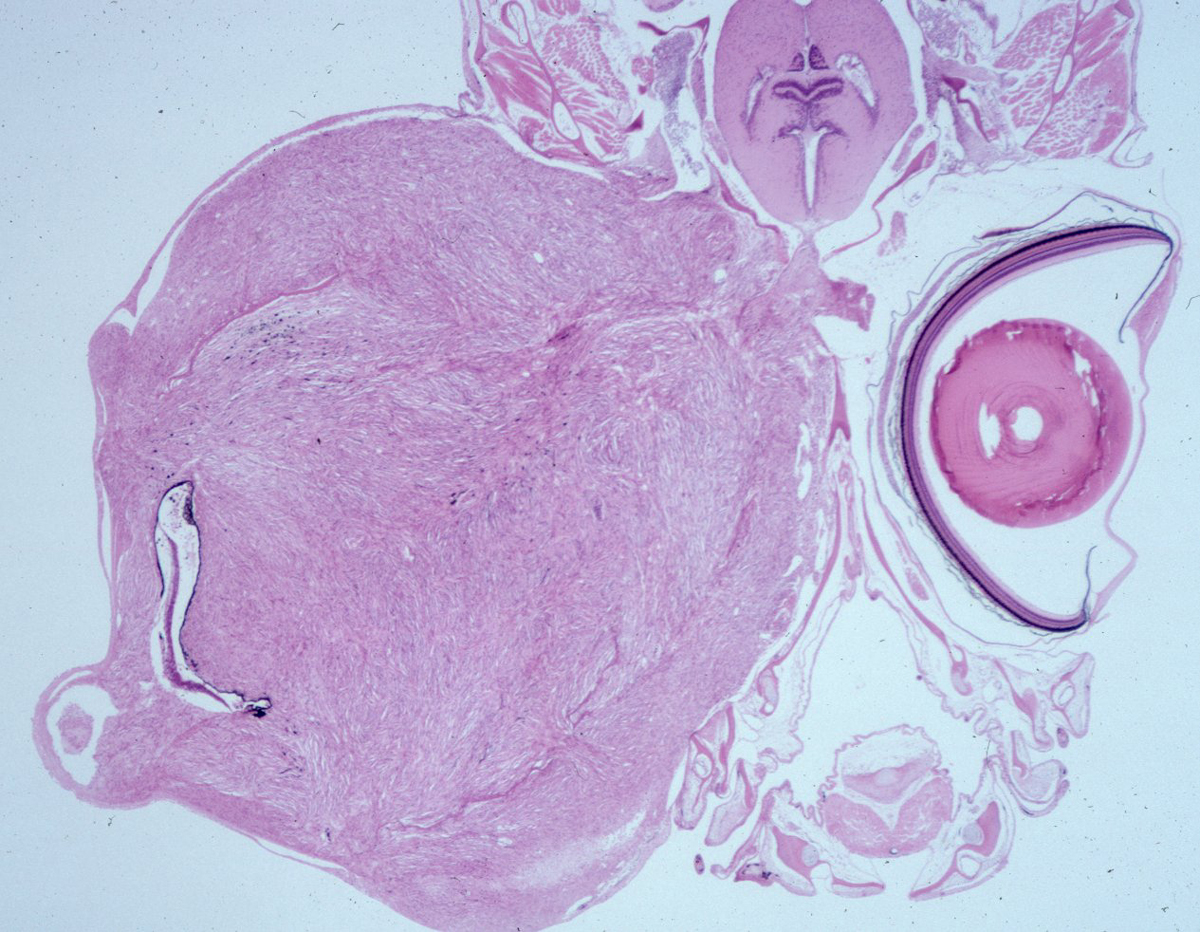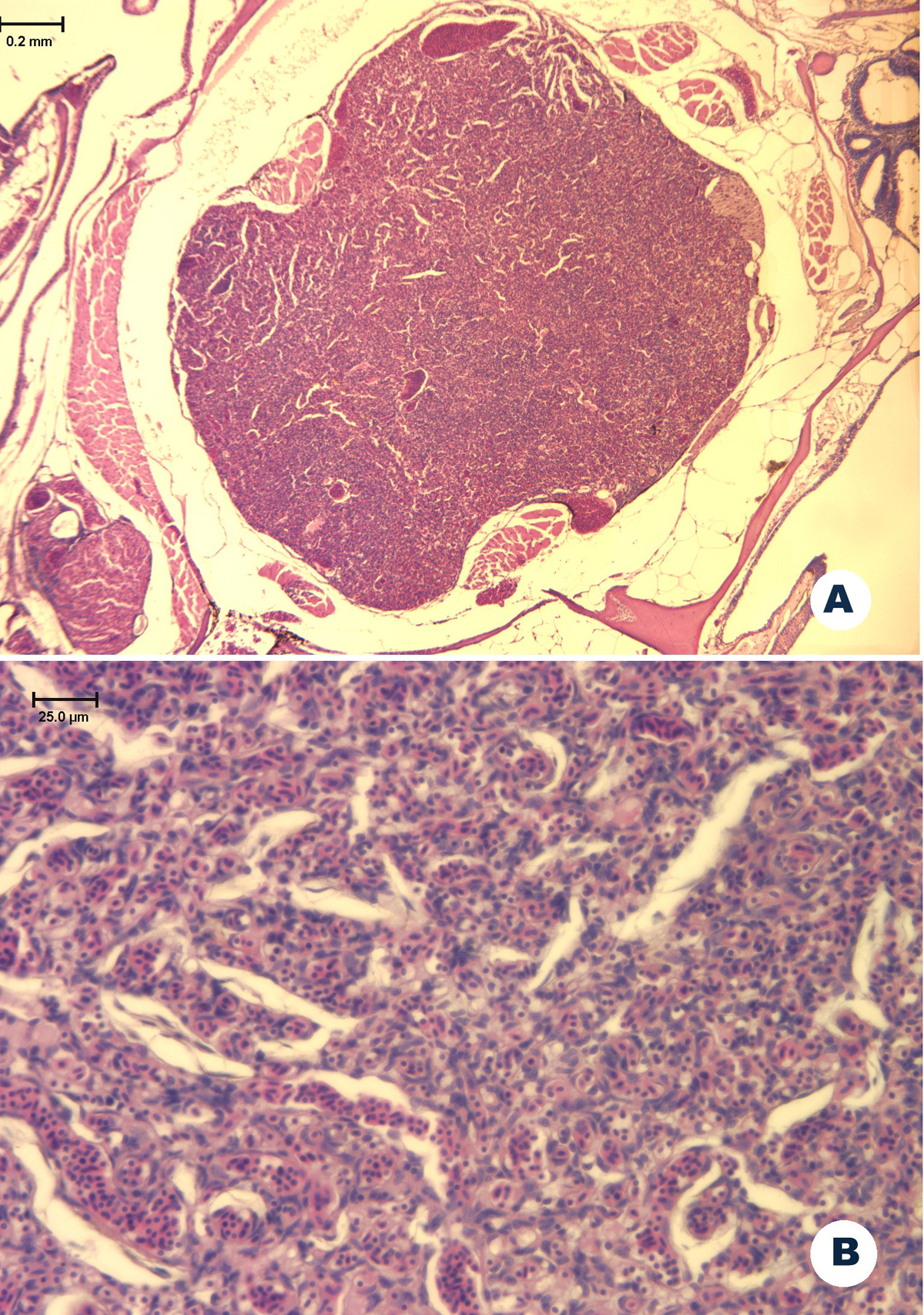Table of Contents
Neoplastic Diseases
In comparison to rodents and other mammalian species, little information is available regarding the incidences or histological types of neoplasia occurring in various wild-type or mutant lines of zebrafish. Based on data from laboratory rodent colonies, we expect incidences and histological types of neoplasia in zebrafish to vary widely among different wild-type and mutant lines.
Pioneering work by Dr. Mearle Stanton of the National Cancer Institute in the 1960s was the first research demonstrating experimental carcinogenesis in fish. This work showed that the zebrafish developed liver neoplasia after exposure to diethylnitrosamine or methylazoxymethanol acetate (Stanton 1965; Stanton 1966). In a 5-year U.S. Army-funded study of neoplasia induced by a panel of structurally diverse carcinogens, Drs. Jan Spitsbergen and Jerry Hendricks of Oregon State University showed that zebrafish of a Florida wild-type line (from a commercial wholesaler) are quite responsive to most carcinogens if exposed early in life. Liver was the most commonly targeted organ in these carcinogen studies with zebrafish, but as with other carcinogenesis studies in small aquarium fish (Bunton 1996), a wide variety of epithelial, mesenchymal, neural, and neural crest neoplasia occurred in fish exposed to many of the carcinogens (Hendricks 1996; Spitsbergen et al. 2000a; Spitsbergen et al. 2000b; Spitsbergen et al., 1997). A recent study at Pennsylvania State University found a 100% incidence of cutaneous papillomas in 18 zebrafish by 1 year after three immersion exposures at the adult stage to 2.5-3 mM ethylnitrosourea. The strain of zebrafish used in this papilloma study was not specified, but was presumably Florida wild-type as they were obtained from North American wholesaler.
At Oregon State University, the spontaneous rate of neoplasia in the Florida wild-type line fed a semi-purified diet and held in a flow-through system was approximately 1% at 6-14 months of age based on 3,000 untreated control fish. The most common spontaneous neoplasms at 6-14 months of age were seminoma, hepatocellular adenoma, and adenoma of exocrine pancreas, with intestinal adenocarcinoma being less common. A study of 21 Florida wild-type zebrafish over 18 months of age by Dr. Gary Marty indicated that 44% of males had marked hyperplasia or neoplasia of seminiferous epithelium of testis (Dr. Gary Marty, School Vet. Med. U.C. Calif., Davis, pers. comm.).
Current Studies of Neoplasia in Zebrafish at the University of Oregon and Oregon State University
Beginning in 2001, a collaborative study of causes of spontaneous neoplasia in zebrafish is being conducted by Drs. Jan Spitsbergen and Michael Kent of Oregon State University and Dr. Monte Westerfield of the University of Oregon. Their goals are to establish baseline information on the incidences and histological types of spontaneous neoplasia occurring in various wild-type and mutant lines of zebrafish, and to determine the relative roles of genetic factors, infectious diseases, dietary factors and other environmental and husbandry factors in contributing to neoplasia in zebrafish. We are conducting histological examination of retired broodstock to determine incidences and histological types of neoplasia in various lines of zebrafish. We are comparing spontaneous incidences of neoplasia at 2 years of age in groups of wild type (AB line) fed different diets. We are also investigating evidence of viral agents in zebrafish neoplasms by a variety of methods including virus isolation attempts in cell culture, tumor transmission trials and ultrastructural studies of tumor tissue and tumor cell lines.
Neoplasia in Diagnostic Cases Submitted to the Zebrafish International Resource Center
Until 2001, retired broodstock from the Eugene zebrafish colony have not been routinely examined by histology. However, moribund fish and fish exhibiting grossly visible masses or other pathologic lesions have been studied by Dr. Kent since 1994. Also since 1999, the Zebrafish International Resource Center has coordinated a diagnostic service to evaluate zebrafish health problems. Several neoplasms have been diagnosed in cases submitted through this service. Including diagnostic cases from the University of Oregon and submissions from other research centers, the most common target tissues for spontaneous neoplasia are testis, gut, thyroid, liver, peripheral nerve, connective tissue, and the ultimobranchial gland. Less common target tissues include, blood vessels, brain, gill, nasal epithelium and the lymphomyeloid system.
Although we are just beginning to accumulate data regarding age-specific incidences of neoplasia in various lines of zebrafish, it is clear that the incidence of neoplasia increases strongly with age over one year in the lines examined. For example, the incidence of seminomas (neoplasms of the seminiferous epithelium of testis) is typically less than 1% in fish of all lines examined so far at less than 1 year of age. But the incidence of seminomas increases to approximately 40% by two years of age or more.
The following are descriptions of the common neoplasms that we have observed at our facilities in Oregon and from diagnostic cases from other research facilities.
Seminoma
Macroscopic Changes
Seminomas are the most common spontaneous neoplasms observed in our diagnostic cases. In older broodstock, these neoplasms are often huge in size, causing marked abdominal distention, and constituting about half of the body mass. These neoplasms are typically soft, white, multilobulated masses and, in our experience, have always been confined to the testis.
Microscopic Changes
Unlike most seminomas of mammals which are comprised principally of a monotonous sheet of germ cells, most seminomas of fish are spermatocytic seminomas with extensive differentiation of germ cells into various developmental stages up to sperm (Hawkins et al. 1996). Small seminomas may be comprised of a single lobule of proliferative seminiferous epithelium compressing the surrounding normal testicular tissue. Large seminomas may be multilobular. Various ratios of primordial germ cells to differentiating spermatocytes and spermatids may occur in different seminomas. Most of the seminomas that we have seen are well differentiated, with histological structures evident that are typically found in normal testes.
Intestinal Carcinoma
Macroscopic Changes
These cases are most commonly recognized only on histology. In extreme cases, a visceral mass may be observed on necropsy which is soft to firm and tan in color. Intestinal carcinomas occur most commonly in the anterior portion of the intestine, just distal to the esophagus (zebrafish have no stomach). The capillarid nematode Pseudocapillaria tomentosa may be a promoter of these neoplasms (see section on Pseudocapillaria and Kent et al. 2002).
Microscopic Changes
These neoplasms may vary from small focal, relatively well-differentiated neoplasms forming acini to large highly invasive neoplasms comprised of poorly differentiated small round malignant epithelial cells (small cell carcinoma). Poorly differentiated neoplasms may extensively invade adjacent pancreas and viscera.
Ultimobranchial Neoplasia
The ultimobranchial gland is an endocrine structure that occurs transiently during the development of mammals, but remains a distinct organ in adult fish and birds. This gland of fish is the counterpart to the thyroid C cells (medullary thyroid tissue) in mammals. Like C cells, the ultimobranchial gland secretes calcitonin to regulate blood calcium levels. Studies of both diagnostic cases from moribund fish and retired broodstock indicate that the incidence of ultimobrachial neoplasia increases substantially in fish over 1.5 year of age. In most lines of zebrafish, we typically do not see a mass grossly in fish affected by ultimobranchial tumors, but usually detect this tumor during histologic studies. Because both seminomas and ultimobranchial tumors are common in male fish over 1.5 year of age, we often see these tumors together in older males. We have seen several cases in the Tübingen long fin line [also called TUP longfin, TL, leopard (leo) long fin (lof)] in which the abdomen was grossly distended due to marked enlargement of the spleen in fish with ultimobranchial neoplasia. In these cases the spleen was up to 30X normal size, with cystic degeneration, perhaps due to passive congestion. Ascites also occurred in some cases. The TL line raised in standard husbandry systems on commercial diets seems prone to develop ultimobranchial tumors at a relatively young age, with some neoplasms seen by 6 months of age.
Macroscopic Changes
We have only detected these neoplasms by histology.
Microscopic Changes
The normal ultimobranchial gland of the zebrafish is a small ovoid organ located between the heart and the esophagus. Because of the small size of the normal organ, we must typically cut many step sections through the midline region of a fish to obtain reliable sections of the ultimobranchial gland. The normal gland consists of a cluster of acini lined by tall columnar cells, with basally located nuclei. Neoplastic ultimobranchial glands may be enlarged up to 50X normal size. It is remarkable that fish can tolerate such large masses compressing or invading the heart. Neoplastic ultimobranchial cells lose their tall columnar structure and acinar arrangement, forming packets or monotonous sheets of ovoid to polygonal neuroendocrine cells. Malignant neoplasms are composed of less differentiated epithelial cells which invade through the fine fibrous capsule which surrounds the normal gland. We have observed several cases in which large ultimobranchial carcinomas have invaded into the sinus venosus of the heart.
Thyroid Neoplasia
Macroscopic Changes
These neoplasms occur as soft white, often multilobulated masses on the ventral aspect of the lower jaw. Thyroid neoplasia must be differentiated from goiter histologically. Goiter in fish can occur when diets and the aquatic environment are low in iodine or when goitrogenic chemicals are present. Goiter can present with very large masses on the ventral jaw and surrounding the gills.
Microscopic Changes
Histological diagnosis of benign and malignant thyroid neoplasia in fish has been controversial because, unlike the thyroid in mammals which is encapsulated, in fish, most thyroid follicles occur diffusely in connective tissue surrounding the ventral aorta in the lower jaw. In certain fish species, normal thyroid tissue can occur in a variety of locations including spleen and anterior kidney (Hoover, 1984). In our experience, normal thyroid tissue of the zebrafish is confined to the vicinity of the ventral aorta of the lower jaw. Several diagnostic cases of thyroid neoplasia that we have described have included foci of highly anaplastic epithelial cells which are clearly malignant histologically, and in certain cases have invaded many tissues throughout the body. These cases have been confirmed as malignant thyroid adenocarcinomas by Dr. John Harshbarger of the Registry of Tumors in Lower Animals.
Hepatic Neoplasia
Macroscopic Changes
Benign or malignant hepatocellular neoplasms (hepatocellular adenoma or hepatocellular carcinoma) have been the most commonly observed hepatic neoplasms in diagnostic cases. These neoplasms are soft white to tan masses that may be single or multiple in the liver, and may bulge above the surface of normal hepatic tissue. Liver tumors are frequently observed in fish exposed to chemical carcinogens, in both lab studies or in fish from polluted water. However, we have also seen liver tumors in zebrafish with no known history of exposure to carcinogens.
Microscopic Changes
Hepatocellular adenomas are neoplasms comprised of well-differentiated hepatocytes that maintain their normal orientation into hepatic plates, but which form proliferative masses compressing surrounding hepatic parenchyma. Hepatocellular carcinomas are comprised of more anaplastic hepatocytes, which have typically lost their normal organization into hepatic plates and often extensively invade into surrounding normal hepatic tissue.
These neoplasms are often associated with foci of hepatocellular alteration. These are clusters of hepatocytes that stain differently from normal hepatocytes, such as a cytoplasm that is more eosinophilic, more basophilic or more vacuolated due to glycogen accumulation. However, they maintain their normal orientation into hepatic plates and do not compress the surrounding parenchyma. Carcinogenesis studies in mammals and fish indicate that these foci of hepatocellular alteration are often precursors to hepatic neoplasms. Another liver tumor that is not uncommon in fish are those with a biliary origin – e.g., choangiocelluar carcinomas, biliary carcinomas.
Spindle Cell Sarcomas
Macroscopic Changes
These lesions may occur in viscera, skeletal muscle, or behind the eye, causing exophthalmia, often as whitish, solid masses. It should be noted that other tumors (e.g., capillary hemangiomas) may also occur in the eye socket .
Microscopic Changes
Fibrosarcomas (malignant neoplasms of fibroblasts), leiomyosarcomas (malignant neoplasms of smooth muscle), and malignant nerve sheath neoplasms are difficult to distinguish from one another grossly, and when poorly differentiated, they may also be difficult to distinguish histologically. Therefore, the collective term “spindle cell sarcoma” is often used when the precise cell type of the tumor cannot be discerned. We have observed many neoplasms showing cellular architecture consistent with both neural fibrosarcomas and fibrosarcomas.
Hemangiomas
While most eye tumors that we have seen fall within the collective name “spindle cell sarcomas”, we have also observed capillary hemangiomas in the retro-bulbar tissues .
Diagnosis
Diagnosis of neoplasms of zebrafish relies on histological evaluations. At present, we have not yet confirmed the usefulness of immunohistochemical markers for various cell types on formalin-fixed tissues of zebrafish, and thus histological tumor diagnosis often falls within broad categories.
Control and Treatment
As the designation implies, the causes of spontaneous neoplasms in zebrafish are unknown. In addition to chemical carcinogens, infectious agents such as oncogenic viruses are well-recognized causes of neoplasms in other fish species, particularly lymphoid or skin tumors (Bowser and Casey 1993). However, we have yet to identify such agents in zebrafish. Our observations from diagnostic cases indicate that older fish are predisposed to higher incidences of most neoplasms. Therefore, removing older fish from colonies should reduce the prevalence of these tumors. Chronic inflammation associated with parasitism is a well recognized as a promoter of neoplasia in mammals and appears to be link to intestinal neoplasia in the zebrafish. In colonies of zebrafish infested with nematodes, intestinal tumors appear to be linked to infections by Pseudocapillaria tomentosa. (See section on **Pseudocapillaria**.) In these cases, eliminating the intestinal nematodes should reduce the occurrence of these neoplasms.
